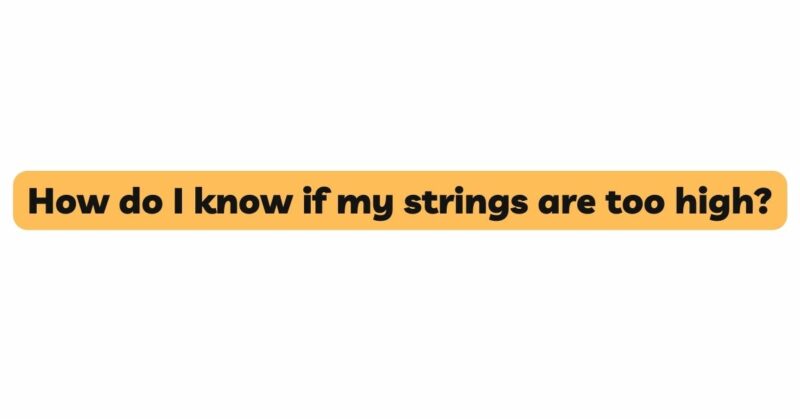The guitar, a timeless instrument known for its ability to convey a wide range of emotions through its melodies, has captured the hearts of musicians and listeners alike. However, like any tool, a guitar requires proper maintenance and adjustments to ensure optimal performance. High string action, a common issue faced by guitarists, can significantly impact playability and sound quality. In this comprehensive article, we delve into the intricacies of identifying excessive guitar string action, discussing the telltale signs, its effects on performance, and the steps you can take to ensure that your instrument is set up for the best possible playing experience.
Understanding Guitar String Action: Guitar string action refers to the distance between the strings and the fretboard. It plays a pivotal role in determining the ease of playability, the ability to produce clear tones, and the overall feel of the instrument. When the strings are positioned too far from the fretboard, the guitar is said to have high string action. Conversely, when the strings are too close to the fretboard, the guitar is said to have low string action.
Detecting Excessive Guitar String Action: Recognizing the signs of excessive guitar string action is essential for diagnosing the issue and making necessary adjustments. Here are key indicators that your guitar strings might be too high:
- Difficult Fretting: The most noticeable sign is the increased difficulty in fretting notes and chords. If you find yourself exerting excessive finger pressure to press the strings down, it’s a clear indication that the strings are positioned too high above the fretboard.
- String Buzzing: High string action can lead to an undesirable buzzing sound when playing certain notes or chords. This occurs because the strings are too far from the frets, allowing them to vibrate against the frets unintentionally.
- Limited Bending and Vibrato: High string action can hinder your ability to perform bending and vibrato techniques effectively. Bending strings requires bending them towards the fretboard, and if the strings are positioned too high, it becomes challenging to execute these techniques smoothly.
- Intonation Issues: Incorrect string action can affect the intonation of your guitar – its ability to play in tune across the fretboard. If your guitar’s intonation seems off, it could be a result of high string action impacting the strings’ length and tension.
- Reduced Sustain and Volume: High string action can dampen the vibrations of the strings, leading to reduced sustain and volume. This can result in notes fading out more quickly than expected and an overall less vibrant sound.
Impact of High String Action on Performance: Understanding how high string action affects your playing experience and the guitar’s sound quality is crucial:
- Playability Challenges: Excessive string height increases the physical demands of playing. The extra finger pressure required to fret notes and chords can lead to fatigue and discomfort during extended playing sessions.
- Intonation Impairment: High string action can negatively impact intonation, causing notes to sound out of tune across different frets. This undermines the guitar’s ability to produce harmonically accurate melodies.
- Technique Limitations: Techniques such as bending, vibrato, and hammer-ons become less responsive and fluid due to the increased distance between the strings and the fretboard.
- Tonal Quality: The strings’ distance from the fretboard affects their ability to vibrate freely. High string action can dampen the strings’ movement, leading to reduced sustain and altered tonal characteristics.
Confirming High String Action: A Step-by-Step Approach: Pinpointing high string action involves a systematic process of observation and assessment. Here’s how you can diagnose and confirm the issue:
- Visual Inspection: Observe the gap between the strings and the fretboard. If the gap appears noticeably large, it’s an initial indication of high string action.
- Fretting Experiment: Play notes across the fretboard and assess the ease of fretting. If you experience resistance or find it difficult to press the strings down, it suggests that the action might be too high.
- Auditory Analysis: Listen for buzzing sounds when playing chords and individual notes. Buzzing indicates that the strings are making unintended contact with the frets due to high action.
- Saddle and Nut Assessment: Examine the bridge saddle and nut. If they appear excessively elevated, they may be contributing to the high string action.
- Professional Consultation: If you are unsure about diagnosing or addressing high string action, consider seeking the expertise of a qualified guitar technician. They can accurately assess the issue and make precise adjustments.
The Role of Professional Expertise: While you can attempt to address high string action on your own, seeking the guidance of a professional guitar technician is recommended. A skilled technician possesses the knowledge and experience to accurately diagnose the issue, recommend suitable modifications, and ensure that adjustments are carried out safely and effectively.
Conclusion: High guitar string action should not deter you from enjoying the instrument’s full potential. By recognizing the signs of excessive string action and understanding its effects on playability and sound, you can take proactive steps to address the issue. Whether you are a novice musician or an experienced player, the journey to achieving optimal string action signifies your dedication to mastering your craft and producing music that resonates with precision and emotion. As you embark on this journey, remember that every adjustment you make brings you one step closer to achieving harmony between your instrument and your musical aspirations.


